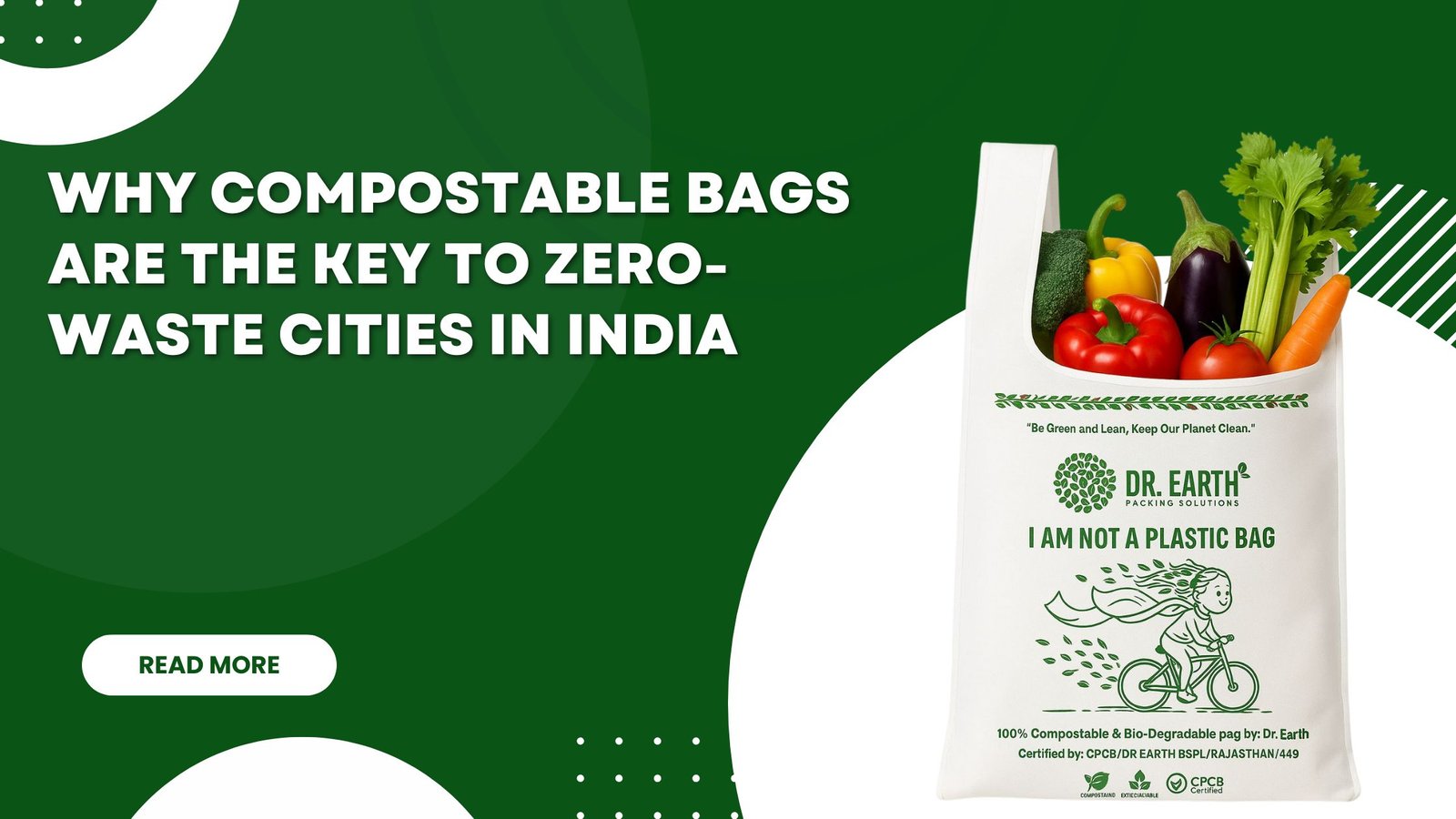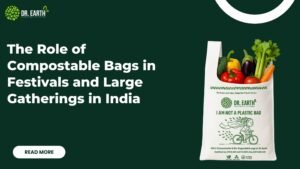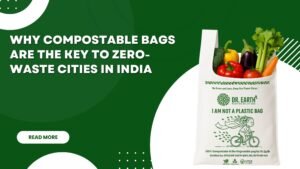
Cities in India are growing faster than ever in population, energy use, and unfortunately, waste. Mumbai, Bengaluru, Delhi: each city produces thousands of tonnes of municipal solid waste each day. A large chunk of that waste is single-use plastics: carry bags, food wrappers, inner liners, courier mailers. These items choke drains, contaminate recyclables, crowd landfills, and create a costly and unhealthy waste-management burden for municipal bodies.
Zero waste cities is not a utopian dream. It is a pragmatic framework for us to transition how we produce, consume and dispose of materials. Compostable bags – when genuinely certified and properly managed – turn a disposable concern into a resource. They close material loops while reducing contamination of recycling streams, and allow for a realistic decentralized, community level organic recycling.
This article will explain why compostable bags matter to India’s zero-waste aspirations, how they fit into existing waste systems, what changes to policy and operations are required, and how cities can scale the solution while not creating new problems.
What “zero waste” really means for cities
The term “zero waste” is often misinterpreted as “no trash.” For cities adopting zero-waste measures, it would look like the following:
- widespread source segregation (wet/organic vs dry/recyclables vs hazardous),
- local composting for food waste and garden waste,
- effective recycling markets for kitchen and office paper, metal, glass, and hard plastics,
- extended producer responsibility (EPR) for plastic packaging,
- and community engagement that helps make citizens participants in their day-to-day responsibilities to protect the environment.
Why compostable bags — not just “biodegradable” plastics — matter
Language matters. “Biodegradable” can mean anything and only means that a product will breakdown in time, which could still leave microplastics behind.
compostable bags are meaningful because:
- They enable source-separated organics to go directly to composting: Wet kitchen waste collected in a compostable liner can be dropped into a compost pile or digester without any manual removal from the compostable bag, saving labor and reducing contamination.
- They reduce microplastic contamination: Plastic cuttings break down soils and pose longer-term impacts to the environment and health. Compostable alternatives eliminate that issue.
- They are made from renewable feedstocks: Certified compostable bags use mostly plant-based polymers (cornstarch, PLA blends, etc.) thereby providing less reliance on fossil fuels.
- They are regulatory compliant: Many national and state policies are now recognizing certified compostables as acceptable alternatives to single-use plastic items that are banned, thus cities that are integrating compostables have a better legal basis.
How compostable bags support source segregation and municipal operations
One of the main barriers to municipal composting is contamination.
- Cleaner organic waste stream: When families collect kitchen scraps in certified compostable bags, the organic waste arrives with minimal plastics or foreign matter. Publicly funded composting facilities can accept organic waste in compostable bags, which offers environmental benefits while speeding up processing and improving the quality of compost.
- Reduced manual sorting: Municipalities are spending considerable labour sorting mixed waste at waste facilities. Compostable bags that break down with the organics eliminate the need to manually sort the regular plastic for disposal.
- Increased safety for workers: Handling and processing mixed, contaminated waste introduces conditions where workers are exposed to sharp or dangerous waste. Cleaner organics reduce that risk.
- Reduced landfill impact: If a large amount of organic waste can be diverted to composting, the volume and organic load of waste in the landfill decrease, which ultimately leads to reduced methane production and less management of the digestate at the landfill.
- More circular outcome: High-quality municipal compost is produced and applied locally — city parks, landscaping, roadside plantings and urban agriculture — thereby closing the loop of nutrients.
Practical use cases: where compostable bags deliver the most value
- Practical Applications: Compostable Bags Provide Maximum Value in These Areas:
- Home composting of wet waste: Families collect food scraps, vegetable peels, and tea leaves in a compostable bag and transfer that as-is into the wet-waste stabilization bin. Then, the local waste collector dumps everything — bag, contents, and all — into a community composter or provides it for processing at a municipal facility.
- Multi-family dwellings & RWAs: Gated community and resident welfare associations can utilize decentralized composting. If compostable liners are utilized, participation will increase because residents do not need to take the extra step to separate or rinse bags.
- Wet markets and vegetable vendors: Wet market stalls create large amounts of organic waste daily (poultry, produce and fish). Using compostable liners makes collecting organic waste easier and convenient to transfer waste to composting hubs nearby.
- Restaurants, cafeterias and food courts: Restaurants create large amounts of organic waste that can be redirected to anaerobic digesters or vermicompost units if the carry bags, liners, and any related packaging are compostable.
- Events/festivals: Temporary events typically generate large amounts of mixed waste. If vendors use compostable carry bags (information, food, or otherwise) and provide compostable plates and utensils, then the wet fraction can be managed on-site.
Certification and standards: the guardrails that prevent greenwashing
Compostable bags can be assured only with the proper certifications, with credible standards, and when compostable bags are used in an accepted composting environment. The city and institution, should prioritize:
- National or international certification (e.g., ISO 17088, EN 13432, ASTM D6400 – or country specific when necessary). Expect lab test reports that describe the assessments completed by accredited laboratories.
- CPCB or equivalent if used in India and documentation that supports the claims of meeting compostable criteria that are relevant to local composting technologies.
- Specific labelling; “Home-compostable” vs “Industrial/Commercial composting required” must be on the label/pack. This minimizes inappropriate disposal.
Without these guardrails, products that are vaguely labelled “biodegradable” can cause more harm than good.
Operational realities: what cities must plan for
Moving to compostable bags is not a single act, it will take action in collection, processing, policy and citizen outreach.
- Infrastructure assessment: Assess the capacity for localized composting (community composter, farmer networks, municipal compost plants, or where needed, industrial composting plants).
- Segregation at the source: Scale up efforts to make wet/dry segregation easy and routine: color-coded bins, door-to-door collections, and incentives for compliance.
- Procurement and standards: It is recommended that municipal procurement defines that they only procure certified compostables. Contracts should stipulate that certification, shelf-life specifications, and storage recommendations be proofed.
- Storage and shelf life: Many compostable films have a limited shelf life. Municipal stores, vendors, and apartment offices are responsible to manage stock rotation and storage in cool, dry places.
- Training and safety: Train collector and facility workers on the differences between compostable and traditional plastics, on how to handle the wet organics, and on using personal protective equipment to remain safe.
- Quality control at the processing units: The composting plans should monitor their input streams, they should also screen for contaminants, snapshots of compost quality so it can be deemed safe for use.
- Data and metrics: Citizen engagement, diverted tonnage, contamination rates and compost quality should all be documented. These key performance indicators show impact and guide course corrections.
Policy levers cities can use to accelerate adoption
- Mandates & incentives: Organizations can require that citywide or government wet-waste collection operate under certified compostable liners, or provide subsidies and/or tax incentives to early adopters, including apartment associations, vendors, and caterers.
- Public procurement: City agencies (schools, parks, and hospitals) need to be required or incentivized to use certified compostable products, which would create a reliable market and drive volume to scale production.
- EPR integration: Packaging producers need to be included under EPR requirements, which could reward compostable and recyclable designs. EPR funds can support the infrastructure for collection and composting.
- Subsidized community composters: Fund and install community composters in high-density residential neighborhoods, marketplaces, and institutional corridors.
- Behavioral nudges: Promote campaigns, competitions between wards or communities, and encourage stated disposal instructions on compostable packaging.
Challenges and how to overcome them
1. Challenge: Cost premium
Compostable bags tend to be more expensive than conventional plastic.
Solution: Bulk municipal procurement, subsidies, shifting the costs from a per bag price to system-wide savings (less in a landfill, less sorting required, worker safety), and providing evidence to substantiate the economic value of the compost produced locally.
2. Challenge: Infrastructure gaps
Not every city has an industrial composting unit.
Solution: Invest in decentralized composting: vermicompost units, localized community composters, and small anaerobic digesters that could serve groups of buildings.
3. Challenge: Contamination and confusion
Households might throw compostables in with recyclables or something that is non-certified.
Solution: Clear, ongoing education; instructions on the products; easy collection for the consumer at the doorstep; and pilot programs with feedback loops to improve behaviours.
4. Challenge: Greenwashing
Products labelled as “eco,” or “biodegradable” but not providing evidence undermine trust.
Solution: Municipal procurement should only recognize clearly labelled products with lab certifications to substantiate the claims and publish the list of approved suppliers
Economic and social co-benefits
- Local jobs: decentralized composting and collection create opportunities for livelihoods within neighborhoods
- Soil and green space: municipal compost enhances tree survival and health, while contributing to urban agriculture
- Health benefits: decreased plastics in drainage translates to lower vector breeding and disease risk
- Social equity: working with cleaner wet waste contributes to easier, safer working conditions for sanitation workers and informal waste pickers
The role of citizens and institutions
Citizens, resident associations, businesses, schools, and hospitals are all equally important partners. Even small daily choices, such as using certified compostable kitchen waste liners, refusing single-use plastics, or supporting local composting hubs, multiply citywide into measurable impact.
Institutions can model: school lunch programmes, kitchens in hospitals, universities and corporate cafeterias can implement compostable liners and host demonstrations on composting. Community momentum is created with visible acts of leadership.
Conclusion
Compostable bags are far from a panacea; but they are a practical, impactful tool in a zero-waste toolkit. For India’s cities – which commonly have organic waste and stretched municipal budgets – compostable bags can provide practical alignment of citizen behaviour and municipal processing capacity. When certified products, clear policies, decentralized infrastructure and educational opportunities are engaged, a single bag is no longer simply convenient; it is a catalyst for cleaner streets, healthier soil, safer jobs and resilient circular systems.
Zero-waste cities are not built in a day, they are built with thousands of small decisions; the type of bag we use for kitchen peels, the type of waste a school uses for an event, and the RWA that adopts a community composter. In that mosaic, compostable bags provide that stitching together possibility and practice. Suppose India’s cities are to make good on closing material loops and be an in good faith steward for future generations. In that case, compostable bags must be a centre-piece of the solution and regulated at scale.
FAQs
Q-1. Aren’t compostable bags just more plastic?
Ans-No, certified compostable bags can be plant-based polymers that were designed to break down into benign components under industrial or at-home composting conditions, and will not disintegrate into microplastics like so many petroleum-based “biodegradable” products.
Q-2. Can I use any compostable bag for home composting?
Ans-Not necessarily. Some compostable bags are certified for industrial composting (high heat) only, while others carry home-compostable ratings. Always check the label for “home compostable” or “industrial composting required.”
Q-3. Will compostable bags contaminate recycling?
Ans-If compostable materials are mixed into dry recyclable streams, they can cause contamination. The solution is robust source segregation and clear consumer guidance: compostable with wet organics, recyclables in a separate stream.
Q-4. How cost-effective are compostable bags at scale?
Ans-Unit costs are higher, but system savings — reduced landfill use, lower manual sorting, higher quality compost, and avoided fines for plastic bans — can make the overall economics favourable. Bulk municipal procurement further reduces per-unit cost.
Q-5. How can an RWA or school start using compostable bags?
Ans- Begin with a pilot: commit to certified compostable liners for wet waste, partner with a local composter, educate residents/students, and measure diverted tonnage and compost quality before scaling.
Share:
Related Posts














